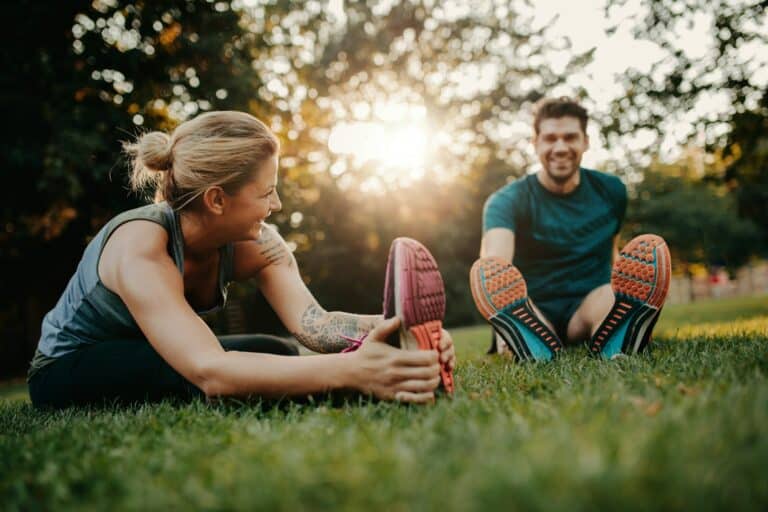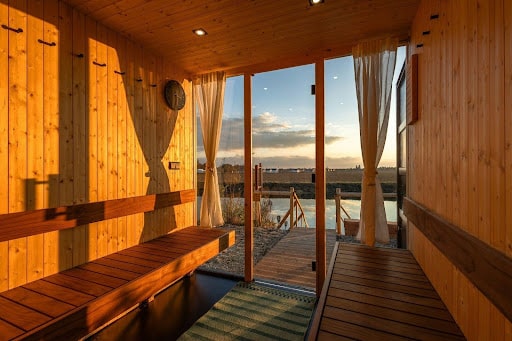Your body goes through a lot when you exercise. The ingeniously designed and complex systems of the body all work together to balance and regulate the temperature of the internal and external systems. The more you exercise, the more heat your body is going to produce. Sweating helps cool the body and release heat. The human body is programmed to do a tremendous job of self-regulation of temperatures, but extreme heats or extreme colds affect the cardiac system and all the metabolic pathways. For this reason, if you are training in extreme summer heat, you may have to make some adjustments to keep things regulated.
 When you exercise inside, room temperatures are going to present with low humidity and the gradient difference between your skin temperature and the room temperature are not very different. For this reason the thermoregulation of your temperature is easily managed. You may still sweat, but this is a normal response and a way for heat loss to occur. Once you start training in extreme Summer heat, it’s a different ballgame. Because the temperature is so much higher outside than inside, the gradient difference between your skin temperature and the radiation from the Sun is much higher. Well… what does that mean?
When you exercise inside, room temperatures are going to present with low humidity and the gradient difference between your skin temperature and the room temperature are not very different. For this reason the thermoregulation of your temperature is easily managed. You may still sweat, but this is a normal response and a way for heat loss to occur. Once you start training in extreme Summer heat, it’s a different ballgame. Because the temperature is so much higher outside than inside, the gradient difference between your skin temperature and the radiation from the Sun is much higher. Well… what does that mean?
Basically, the way your body cools itself off inside is not as efficient as it is in the presence of extreme Summer heat. Your body will primarily rely on evaporation to say “bye-bye” to the heat. Evaporation is a fancy way of saying sweat. But for the sweat to evaporate, the air around the body has to allow it. When you sweat the fluid from your body (hopefully all that water you drank!) rises to the surface to cool the skin temperature. Once it evaporates and turn into a vapor to release from the body, it takes the heat with it. This is where the dreaded humidity pokes it’s nose where nobody wants it. If you are training in hot, humid conditions, the air around you will be filled with moisture and make it very hard to evaporate the sweat off your body. The sweat seems to make a nest and get comfortable on your skin. You will continue to sweat, which means more lost fluid.
 Drink a lot of water. Hours before you brave the heat, you should consume 17-20 oz to prepare your body for the loss of fluid to occur. Continue to drink water (or another fluid containing electrolytes) during exercise (7-10 oz). If you are a heavy sweater, you should drink more. Don’t forget to replenish your fluid reserves after exercise as well!
Drink a lot of water. Hours before you brave the heat, you should consume 17-20 oz to prepare your body for the loss of fluid to occur. Continue to drink water (or another fluid containing electrolytes) during exercise (7-10 oz). If you are a heavy sweater, you should drink more. Don’t forget to replenish your fluid reserves after exercise as well!
Just as important to drinking water in preparation for training in extreme Summer heat, you need to achieve heat acclimation. There is a long list of how your body gets “used to the heat”, but the long and short of it is that your plasma volume will increase in the blood, and you’ll be able to keep your core temperature down and sweat more to stay cooler. So how do you get acclimated to the extreme heat? Keep the intensity low and work out in the heat for short sessions. You can gradually build up the time you spend outside. Do this for 2 weeks, and you can get acclimated to the heat.
Staying hydrated and getting acclimated to the heat are very important, but equally as important is your attitude and expectations for training in extreme Summer heat. You have to know that you may not be able to do as much or run as fast. If the humidity, temperature, and dew point are dangerously high, its time to skip a workout or seriously lower your goals. You could always take the workouts indoors at your local gym!


